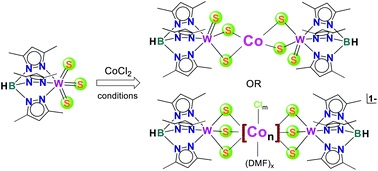陈旭东教授课题组在DALTON TRANSACTIONS发表研究论文
Templated syntheses of heterometal tungsten-cobalt-sulfur clusters with different nuclearities
Guo, JT (Guo, Jia-Ting)[ 1,2 ] ; Chen, XD (Chen, Xu-Dong)[ 1,2,3 ]*(陈旭东)
[ 1 ] Nanjing Normal Univ, Sch Chem & Mat Sci, Jiangsu Collaborat Innovat Ctr Biomed Funct Mat, Nanjing 210023, Jiangsu, Peoples R China
[ 2 ] Nanjing Normal Univ, Sch Chem & Mat Sci, Jiangsu Key Lab New Power Batteries, Nanjing 210023, Jiangsu, Peoples R China
[ 3 ] Nanjing Univ, State Key Lab Coordinat Chem, Nanjing 210093, Jiangsu, Peoples R China
DALTON TRANSACTIONS,202005,49(17),5523-5530
A series of new W-Co-S clusters have been synthesized utilizing the complex [Et4N][(Tp*)WS3] (Tp* = hydridotris(3,5-dimethylpyrazol-1-yl)borate(1-)) as the synthetic template, by rational control of the stoichiometry of reactants and by employment of a reductant or precipitant as an auxiliary reagent. By solubility control or addition of a precipitant to avoid the involvement of Cl- in the reaction, the cluster [(Tp*)WS3](2)Co (2) could be obtained. With different ratios of the Co source to the template, together with the use of an appropriate amount of reducing reagent, clusters [{(Tp*)WS3}(2)Co](1-) (3) and [{(Tp*)WS3}(2)Co2Cl](1-) (4) could be synthesized as their Et4N+ salts, and [{(Tp*)WS3}(2)Co4Cl2(DMF)](1-) (5) could be isolated as its [Co(DMF)(6)](2+) salt. A common structural feature of these clusters is that they all have a pair of [(Tp*)WS3] templates chelating different numbers of Co atoms to form W-Co-S clusters with distinct nuclearities. The clusters [(Tp*)WS3](2)Co (2) and [{(Tp*)WS3}(2)Co](1-) (3) both have one Co atom chelated by two [(Tp*)WS3] templates, and the difference lies in not only the oxidation states but also the fact that the Co atom in 2 adopts an octahedral coordination environment while that in 3 bears a tetrahedral coordination sphere, which means that the [(Tp*)WS3] template is tri-dentate in 2 and bi-dentate in 3. The cluster [{(Tp*)WS3}(2)Co2Cl](1-) (4) has two Co atoms chelated by a pair of [(Tp*)WS3] templates, in which one of the Co atoms is also terminally bound by a Cl- ligand. There are four Co atoms chelated by two [(Tp*)WS3] templates in the cluster [{(Tp*)WS3}(2)Co4Cl2(DMF)](1-) (5), two of which are bound terminally by the Cl- ligands. Studies of redox properties by cyclic voltammetry indicate the existence of two reversible redox pairs related to clusters 2 and 3, respectively.

文章链接:
https://pubs.rsc.org/en/content/articlelanding/2020/DT/D0DT00765J#!divAbstract
版权与免责声明:本网页的内容由收集互联网上公开发布的信息整理获得。目的在于传递信息及分享,并不意味着赞同其观点或证实其真实性,也不构成其他建议。仅提供交流平台,不为其版权负责。如涉及侵权,请联系我们及时修改或删除。邮箱:sales@allpeptide.com